ASUS K53E: Testing Dual-Core Sandy Bridge
by Jarred Walton on April 8, 2011 1:00 AM EST- Posted in
- Laptops
- Intel
- Sandy Bridge
- Asus
Sandy Bridge Gaming Performance, One More Time
After the 3DMark results, and considering our previous look at SNB’s GPU performance, there’s not much new to say here. We’re still working on a full roundup of gaming performance and compatibility testing with Sandy Bridge, similar to what we did with the AMD E-350. Our standard suite of laptop gaming tests all ran without any apparent compatibility problems, but given this list hasn’t changed much Intel has had ample time to make sure these titles work. We’ve run the Low and Medium performance tests, with a selection of competing laptops in the charts below.
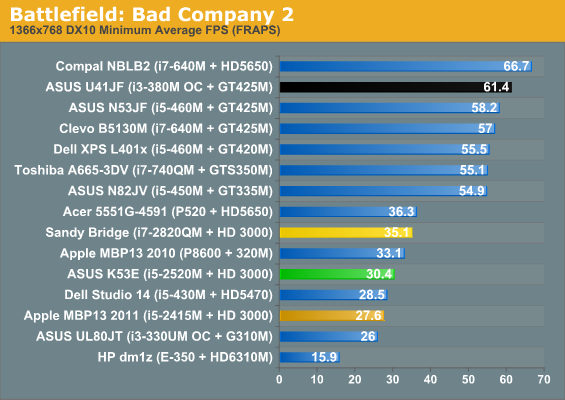
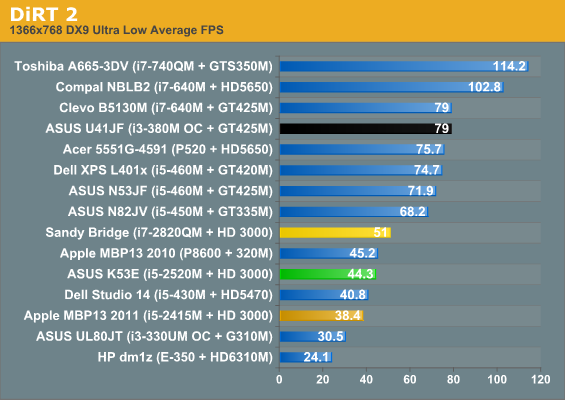
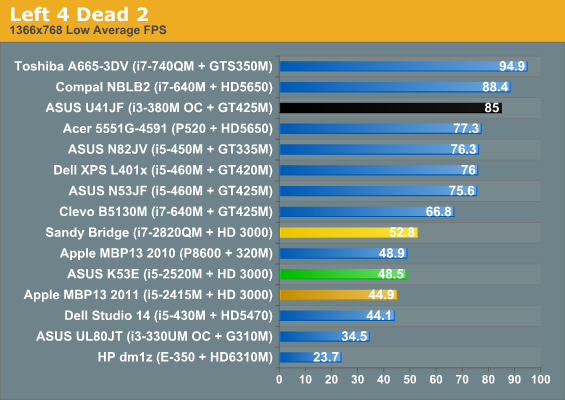
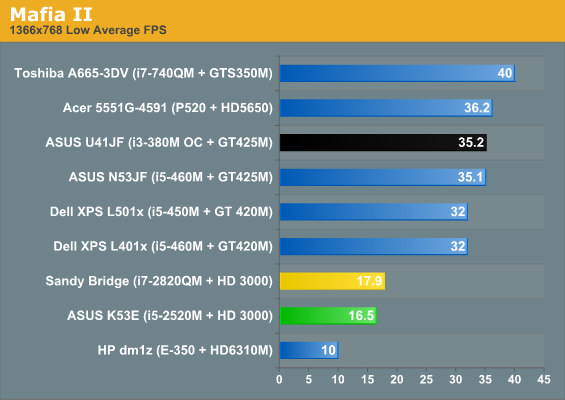
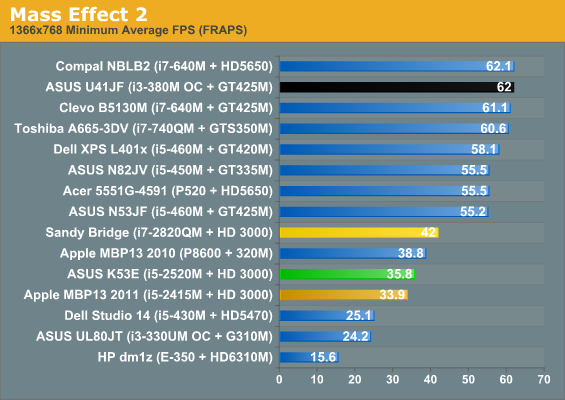
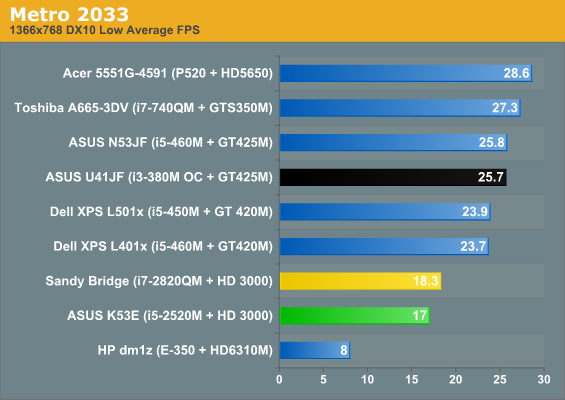
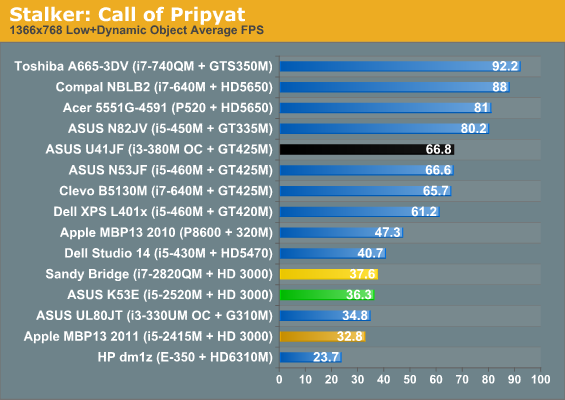
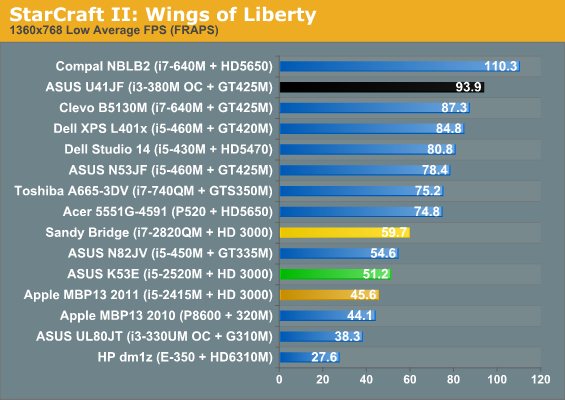
As we noted in the ASUS U41JF review, Intel’s relative standings in graphics are better with 3DMark than with actual games, particularly when we look at midrange GPUs like the GT 425M and HD 5650. Where the U41JF leads the K53E by 53% in the four 3DMark tests, in our eight actual games at low detail that increases to an 82% advantage. The K53E still leads the MBP13 2011 by 10%, and the i7-2820QM in turn leads the K53E by 12%—those results are the same as 3DMark, but then we’re dealing with the same IGP in all those cases. In terms of actual performance, the K53E breaks the 30FPS mark in six of the eight titles—Mafia II and Metro 2033 being the standard exceptions, but then those often fail to break 30FPS even on discrete GPUs.
What about the AMD E-350 comparison? As we just finished discussing, 3DMark shows the K53E coming in 125% faster than the E-350, though as we’ve noted in the past 3DMark can either skew things too much or too little towards CPU performance. Move over to our suite of games and the K53E still posts much higher scores than the E-350, but now the margin of victory is 88%. That’s still nearly twice the performance, and for a complete laptop you’re looking at around $725 versus $500 for similar components elsewhere. 45% more money for 88% faster graphics and 300% faster CPU performance isn’t a bad deal; what you don’t get with Sandy Bridge at that price is 8+ hours of battery life in an 11.6”-screen chassis.
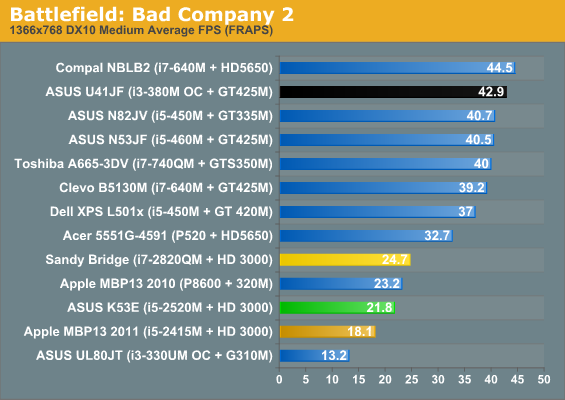


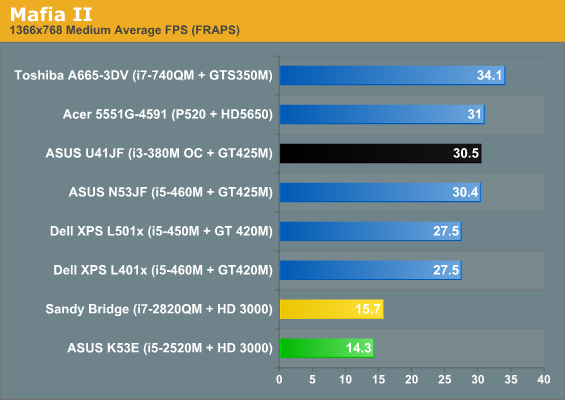

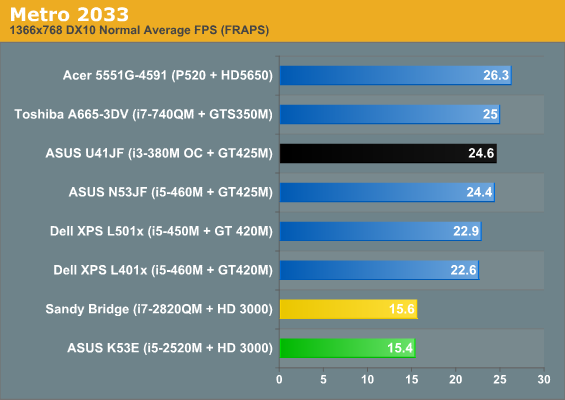
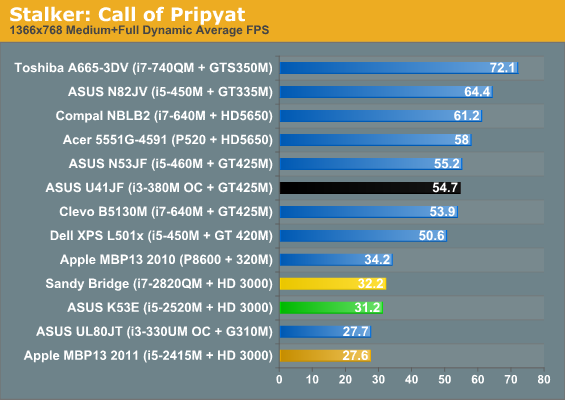
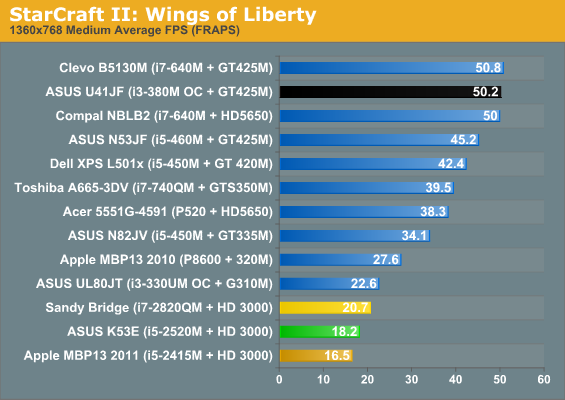
At medium detail settings, HD 3000 performance drops relative to the discrete GPUs. The K53E manages to hit 30FPS or higher in exactly one game this time: STALKER. It’s still 11% faster than the MBP13 2011, and the 2820QM is 14% faster than the K53E. Interesting to note is that the MBP13 2010 is also 15% faster than the K53, putting the GeForce 320M on the same level as the HD 3000 with quad-core CPU. By far the more pertinent piece of information is just how badly the U41JF trounces the K53E: Arrandale with a midrange dGPU comes out nearly 100% faster on average at our “Medium” settings, and it breaks 30FPS in every game in the list except Metro 2033.
For people looking to get an all-around laptop that can play games and provide adequate performance for general use, discrete GPUs are still required. Even then, midrange mobile GPUs are going to struggle with a lot of titles unless you turn down the detail settings and run at moderate (e.g. 720p) resolutions. On the other hand, if you’re not serious about gaming and graphics, Sandy Bridge’s IGP is very likely to satisfy the vast majority of users. Thankfully, it also manages to raise the bar relative to previous IGPs, with roughly double the performance of Arrandale’s HD Graphics and AMD’s HD 4250.
Rounding out the graphics discussion, other areas where the GPU helps also performed well. Viewing HD 1080p YouTube videos worked without any issues I could detect, thanks at least in part to the latest release of Adobe’s Flash player. Casual browser games like Bejeweled Blitz also worked fine, which isn’t something I could say on Arrandale where there was always a slightly perceptible delay—and that’s also a complaint I had with Brazos, which didn’t do well with Bejeweled Blitz. One interesting piece of information, however, is that the K53E really did poorly in Civilization V testing (not shown here, but you can see the scores in Mobile Bench), but whether that’s a driver problem or something else I can’t say.
Overall, gaming and graphics isn’t an absolute victory for Intel’s latest IGP, but it’s good enough for a large percentage of users. In the next month or so, we’ll see AMD’s counter to SNB with their second Fusion APU, Llano. That should provide at least double the GPU performance of Brazos, and even the aging K10.5 CPU core is a huge step up in performance from Bobcat. The combination should put Llano well ahead of HD 3000 in gaming, but whether it will be 50% faster or 100% faster we can't say for certain.
With a 32nm process technology and better use of power gating, Llano is going to be an interesting alternative, especially if the total system cost is similar to the $500 to $650 we’re seeing on current AMD notebooks. Sandy Bridge is unlikely to be touched for CPU computations by any of AMD’s mobile CPUs for the remainder of 2011, but with up to 400 Stream Processors Llano should come relatively close to the HD 6500 (HD 5600) series GPU performance. Put another way, while Intel’s HD 3000 is about twice the performance of Brazos’ IGP, Llano could easily double HD 3000. It’s a welcome change from the 15 to 25% improvements in IGP performance we often saw in previous platforms.










78 Comments
View All Comments
DanNeely - Monday, April 11, 2011 - link
Llano's IGP have the potential to be moderately faster than the current entry level mobile IGPs. On paper it's the equivalent to a 6630-6730M. Having to share the DDR3 memory with the CPU will probably hold it back somewhat, but it very much has the potential to a viable part for light gaming systems.mino - Tuesday, April 12, 2011 - link
"to be moderately faster than the current entry level mobile IGPs"Is that a joke or what ?
Llano has the potential to challenge the mid-range mobile GPU market with even its cheapest version running circles around any other IGP/APU around.
kevlno3 - Saturday, July 30, 2011 - link
Pls dont comments when you not read review. Mino , i 100% support you. Llano is the IGP is same speed as HD5650 ,HD6550 or even HD6630. it's not HD5470 or even HD3000 can be compare.it's totally complete solution for value of money best buy. but Intel keep creat the high benchmark score to blur the consumer . try to make people feel regret if you pay such money to buy the low end Llano. in fact , i was totally disappointed with Intel. Core i3 2310 can't perform well. i even felt lag when i play in war craft 3 frozen throne in battlenet during 3 vs 3. i can't find my pointer. it's normally lag will make u have this problem.
biostud - Friday, April 8, 2011 - link
both s and b models :)jonup - Friday, April 8, 2011 - link
Just from curiosity, does dropping from dual channel to single channel have any significant effect on the performance of the modern laptops/desktops? Many manufactures have been shipping their laptops with odd RAM capacities 3GB/6GB, which has been a turnoff for me, but it appears to be a good marketing gimmick for those who have no clue.Thank for the nice laptop reviews you guys put out there!
IntelUser2000 - Friday, April 8, 2011 - link
The manufacturers I think bundle the smaller capacity DIMM for free so sell that and get a matching stick from NCIX or something.The way the asynchronous dual channel(Intel Flex Memory) works is only half of the greater capacity DIMM is transferring data simultaneously with the smaller DIMM.
So:
4GB + 2GB
4GB stick: 2GB Dual channel + 2GB Single channel
2GB stick: This is doubled up with half of the 4GB stick
So in theory your max bandwidth is like 1.5 channels. Measured bandwidth is between single and dual channel too, but the complexity of splitting the greater capacity puts performance closer to a single channel in some applications.
mino - Tuesday, April 12, 2011 - link
It does not work that way. In any mixed config the IMC falls back to a single-channel-like operating mode.JarredWalton - Tuesday, April 12, 2011 - link
It would be nice if you at least tried to do some research before making completely false statements. Flex memory works exactly as IU2k describes, with basic details here:http://www.intel.com/support/motherboards/desktop/...
Pretty much every Intel CPU/chipset since the P45/X38 has supported flex memory. All you have to do is check ARK:
http://ark.intel.com/Product.aspx?id=52229&cod...
Quote: "Intel Flex Memory Technology -- Facilitates easier upgrades by allowing different memory sizes to be populated and remain in dual-channel mode." Don't confuse limitations of older chipsets and AMD's (older) IMC with current implementations.
silverblue - Friday, April 8, 2011 - link
...that Brazos isn't clocked higher nor operates on a dual channel memory bus. It would be amusing to expect a 500MHz GPU sporting a bandwidth limitation with a mobile part which is 650MHz and, with Turbo, 1.3GHz, and utilises a dual-channel bus, and that's well before we factor CPU performance into things.For what it does, Brazos is excellent, but people really shouldn't think of it as competition for Sandy Bridge. It's really not meant to be anywhere near close to it in terms of performance or price, and it's a shame that some manufacturers seem to have forgotten that. Unfortunately, as said before, Brazos machines may encroach on CULV territory...
IntelUser2000 - Friday, April 8, 2011 - link
An error and few points I'd like to make:"Even the U41JF can’t match the K53E for efficiency, despite underclocking the i3-380M to 700-900MHz (instead of the normal 933-1200MHz) and having a smaller 14” LCD."
i3-380M is a 2.53GHz part. Why are you testing an underclocked version on the battery life test again?
"What really impresses me is that you can get similar battery life (in light workloads) with either the dual-core or quad-core SND parts,"
Huh. Equalizing to battery capacity:
DC(QC) min/WHr
Idle: 7.66(6.63) +15.5%
Internet: 6.43(5.86) +9.7%
H.264 playback: 4.77(3.66) +30.3%
10-15% increase in battery life is not identical. Also, the screen on the QC system is larger, but sports a more efficient SSD drive. If the Hurry up and Get Idle works well, it would be better on the QC thanks to the SSD.
"Ah, but the E-350 has a much better IGP, right?"
I'm not sure whether that's a question or a statement. While the E-350 has a HD5450/5470 core, its severely bottlenecked by memory subsystem, in addition to having it share with the GPU, before the CPU differences.
"The result is better battery life, but compared to Arrandale it’s not a huge change in two of our tests."
SNB DC(ARND)
Idle: 7.66(6.64) +15.3%
Internet: 6.43(5.29) +21.6%
H.264 playback: 4.77(3.07) +55.3%
While Idle and Internet battery life isn't big as H.264, 15-20% battery isn't something minor. In fact, if you look back to Core 2 vs Core Duo and Penryn vs Merom comparisons, the battery gains are equal to 2x for the ones back then.
Overall I think the DC Sandy Bridge is being underrated on the review. The asynchronous RAM is a bit of a sore to look at too. Last benchmark I put the bandwidth figure at somewhere between single and dual channel, and Intel documents indicate increased latency when transferring between sticks.